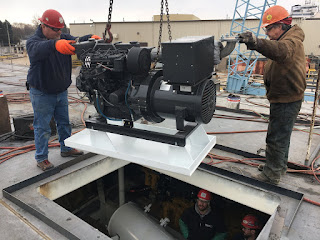Detroit Harbor, Washington Island -
This morning Rich Ellefson sent several photos that demonstrate the move of the Madonna hull, with a good portion of superstructure now attached, back indoors. Work will continue in Fincantieri Bay Shipbuilding's Bldg. 411, a large workplace off of Third Ave., formerly owned by Palmer Johnson Yachts. There, work will begin again in earnest once again with various tradesmen for "outfitting," which means, basically everything from painting to insulating, wiring, piping and so forth need to make this cold steel hull operable as a ferry vessel.
The Fagioli transporter, according to Rich, has 96 tires to support significant loads. The route through the Bay Ship yard is quite level and shouldn't be a problem, once the unit is underway. It appears as though a worker (as seen above) uses an external control to maneuver axles.
 |
| Easy when you have the right equipment - (Rich Ellefson photo) |
Part of the delay in moving the vessel back indoors was in the wait for this transport unit to be
shipped in sections, and then reassembled again at the Sturgeon Bay facility. It should be noted that, from all I've learned, while there may be common corporate ownership by Fincantieri, work at each yard is under distinct accounting procedures. U. S. government contract work at Marinette Marine must be tracked entirely separate from commercial work by the Bay Ship yard. (Occasionally, Bay Ship may subcontract Navy work for the Marinette yard.)
What sort of international player in shipbuilding is Fincantieri, I've often wondered? While on a cruise of the Baltic in June aboard the Viking Sun, I noted a Fincantieri builder's plaque displayed on that ship. And from my reading of maritime journals over the years, the name Fincantieri pops up among respected, major shipbuilders as much as any. Certainly that is true for the cruise ship and naval vessel construction market.
Every so often I bring home from the ferry dock magazines that describe the maritime industry, both domestic and around the world. It is apparent the Italian-based shipbuilder is a leader, having mastered complex projects, refined modular ship construction, in what seems to me a complicated process of managing shipbuilding facilities around the world. As ship building and ship repair in other maritime markets has diminished in recent years (the North Sea and Norwegian oil supply industry being an example), opportunities have arisen for shifting facility ownership and their work forces toward Fincantieri and the still-rising cruise industry.
Here, then, is what the November 2019 issue of Marine Log had to say about the Fincantieri order books for new vessels (by Paul Bartlett, European Correspondent):
Vard, owned by Italy's Fincantieri, has nine shipyards, with five in Norway and others in Romania, Brazil and Vietnam. Cruise ship construction is very much the focus at Norwegian facilities which, like other years in Norway, were previously specialists in high-end offshore vessels. Two expedition cruise vessels are under construction for Hapag-Lloyd Cruises at Vard Langsten, and five more are being buldt at Vard Soevikens, three for French cruise line Ponant SA, and two for Los Angeles-based Viking Ocean Cruises.
This piece went on to enumerate other Fincantieri ship construction work in Europe, orders that fill a 112-ship cruise orderbook at estimated worth of $67 billion, contracts that may extend 7-8 years at least. Another 44 cruise vessels are either underway or planned for Fincantieri's Italian yards, seven at Vard (Norway) and ten at a former French shipyard. The ability of this shipbuilder to understand the global market, and to manage complex projects, makes it understandable why this company saw opportunity in the two, former Manitowoc Marine facilities, located here on Green Bay/Lake Michigan waters.
Ours is a very small project in light of a much larger picture, but we are often reminded, as evidenced by comments and worker attitude at Bay Ship, that this one is special for them, too, one of the few projects they have a hand in that is a home-built vessel for home-waters usage.
- Dick Purinton























